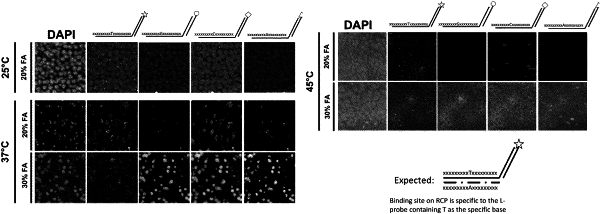| CPC C12Q 1/6874 (2013.01) [C12Q 1/6813 (2013.01); C12Q 1/6816 (2013.01); C12Q 1/6844 (2013.01); C12Q 2537/1373 (2013.01)] | 17 Claims |

|
1. A method of analyzing a sample comprising a target nucleic acid analyte, comprising:
a) contacting the sample with a probe that binds to the nucleic acid analyte,
wherein the probe comprises a barcode sequence that identifies the nucleic acid analyte,
wherein the barcode sequence is associated with a signal code sequence comprising a sequence of optical signals that identify the barcode sequence, and
wherein the sample is a permeabilized cell or tissue sample on a solid substrate;
b) circularizing the probe;
c) amplifying the circularized probe to produce a rolling circle amplification (RCA) product in the sample, the RCA product comprising multiple complementary copies of the barcode sequence;
d) contacting the sample with a first detection probe and a first reporter probe to generate a first complex comprising the first detection probe hybridized to the RCA product and the first reporter probe hybridized to the first detection probe,
wherein the first detection probe comprises (i) a recognition sequence that binds to a complementary copy of the barcode sequence and (ii) a first overhang sequence, and
wherein the first reporter probe comprises (i) a sequence complementary to the first overhang sequence and (ii) a first optically detectable moiety;
e) imaging the sample to detect the first optically detectable moiety, thereby detecting a first optical signal of the signal code sequence;
f) removing the first detection probe from the RCA product;
g) contacting the sample with a second detection probe and a second reporter probe to generate a second complex comprising the second detection probe hybridized to the RCA product and the second reporter probe hybridized to the second detection probe,
wherein the second detection probe comprises (i) a recognition sequence that binds to a complementary copy of the barcode sequence and (ii) a second overhang sequence, and
wherein the second reporter probe comprises (i) a sequence complementary to the second overhang sequence and (ii) a second optically detectable moiety;
h) imaging the sample to detect the second optically detectable moiety, thereby detecting a second optical signal of the signal code sequence,
wherein the signal code sequence comprising at least the first optical signal and the second optical signal is detected at a location in the sample; and
i) using the signal code sequence to identify the nucleic acid analyte at the location in the sample.
|